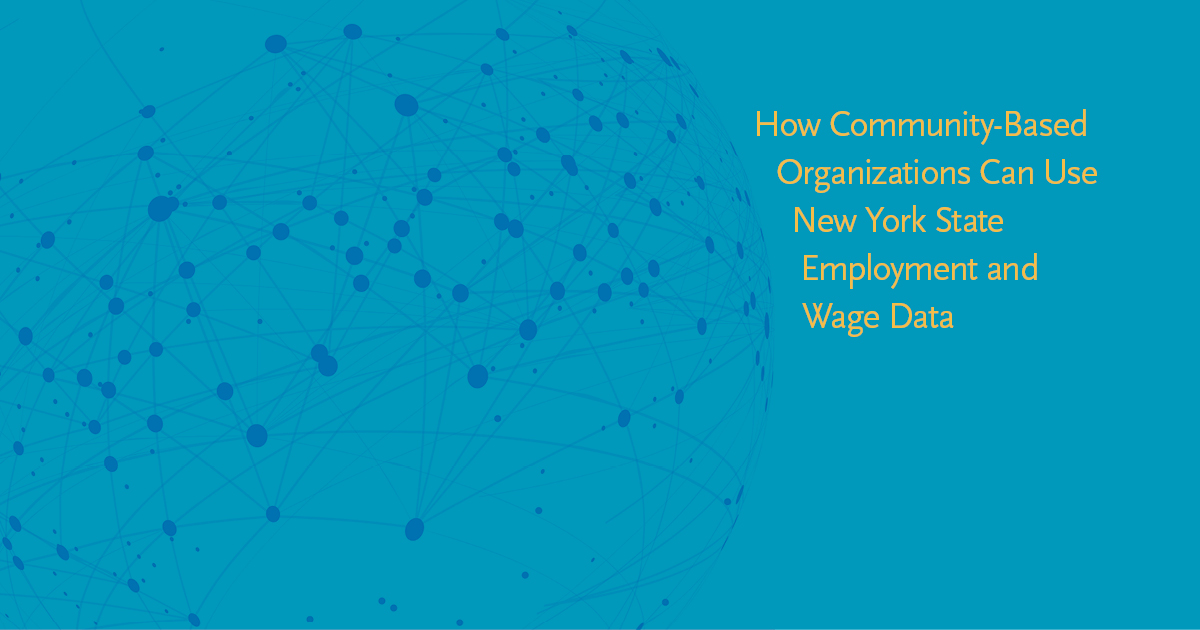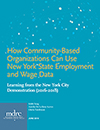How Community-Based Organizations Can Use New York State Employment and Wage Data
Learning from the New York City Demonstration (2016-2018)

 Workforce development organizations often find it challenging to assess how former program participants are faring in the labor market, since they need to rely on participants’ willingness to report and verify their job placements after they either leave or complete their programs. The 2013 Unemployment Insurance Data Sharing Bill (S5773A) amended the New York State Labor Law to make it easier for government agencies to obtain state unemployment insurance (UI) wage data for program monitoring, improvement, and evaluation purposes. In 2016, the Change Capital Fund (CCF) and the New York City Mayor’s Office for Economic Opportunity (NYC Opportunity) identified the law as a chance to invest in a demonstration with four community development organizations that were already CCF grantees, aiming to expand their ability to collect and use data to improve their programs in coordination with the city government.
Workforce development organizations often find it challenging to assess how former program participants are faring in the labor market, since they need to rely on participants’ willingness to report and verify their job placements after they either leave or complete their programs. The 2013 Unemployment Insurance Data Sharing Bill (S5773A) amended the New York State Labor Law to make it easier for government agencies to obtain state unemployment insurance (UI) wage data for program monitoring, improvement, and evaluation purposes. In 2016, the Change Capital Fund (CCF) and the New York City Mayor’s Office for Economic Opportunity (NYC Opportunity) identified the law as a chance to invest in a demonstration with four community development organizations that were already CCF grantees, aiming to expand their ability to collect and use data to improve their programs in coordination with the city government.
This report describes that two-year demonstration and is meant to serve as a guide for other New York municipalities and community organizations that may consider requesting access to state UI wage data. It illustrates some of the challenges and opportunities involved in accessing UI data on program participants and offers some practical lessons for organizations in New York State.
Key Lessons
The contract development process with the New York State Department of Labor (NYSDOL) took over a year, during which MDRC served as the data intermediary and provided technical assistance to the community organizations. Once the agreement was executed, MDRC received, processed, and analyzed the data, sharing the findings with each organization. Following are some of the important lessons that emerged from the demonstration:
-
Contract structure is important in securing data access. Under the 2013 law, NYSDOL can share either identifiable (confidential) data or data in deidentified or aggregate form. In order to qualify for access to identifiable data, community organizations must be in a direct contractual relationship with a federal, state, or city agency; for this reason, NYSDOL did not grant access to identifiable data to the community organizations in the demonstration. Deidentified or aggregate data are easier to obtain, so organizations may qualify for data access without an agency partner.
-
Identifiable data are preferred over deidentified or aggregate data, but aggregate data are still informative and valuable. All the CCF grantees would have preferred to receive identifiable data so that they could use them to improve services for specific individuals and have the flexibility for additional analyses as other questions arose. While aggregate results could not address analysis questions as completely as identifiable data could, the grantees still found the data useful for understanding employment trends and earnings averages across key subgroups.
-
Preparation is crucial to benefiting from the data access. Community organizations should make sure that the participant information in their databases is complete and accurate, that staff members have the time and ability to make good use of the data, and that analysis questions are thoughtfully prioritized before investing in a data acquisition effort with NYSDOL, to maximize the value of UI wage data access.
- Wage data can guide program improvements. Carefully planned analyses with UI wage data to track employment and earnings for certain groups of participants can inform program improvements. For example, organizations could examine earnings data to assess whether participants without high school diplomas need different kinds of employment services than do more educated participants.







